Bicycle chains: varieties, selection, installation
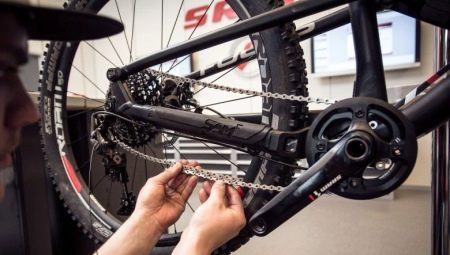
The number of parts and functional units of a bicycle includes dozens of important elements, without which the bicycle will definitely not budge. In addition to the integrity of the wheels, brakes, steering wheel and pedals, the condition of the chain is also checked before each ride. A bicycle chain - like a motorcycle chain - is a vital part of the drivetrain, along with the sprockets.
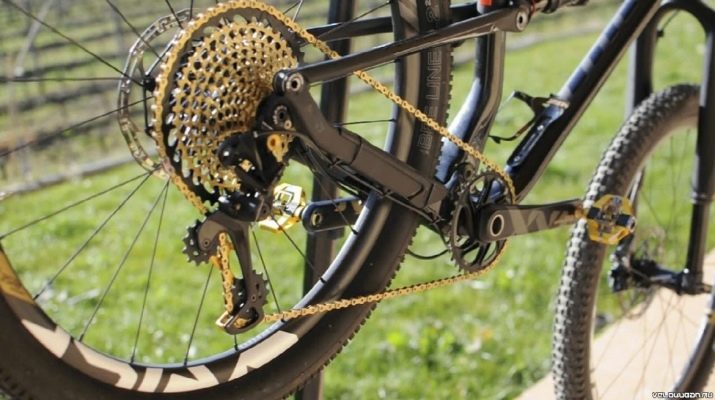
Device
A bicycle chain, in contrast to, for example, an anchor chain, has a slightly different structure. Its links are located approximately in the same plane, and not perpendicular to each other according to the principle "through one". The design of the bicycle chain consists of collapsible links, connected to each other by means of pins inserted (wedged) into the beginning and end of each link. So that the gaps, into which the teeth of the sprockets go, do not narrow, interfering with confident movement, but remain constant along the width of the gap, inside the links connected to each other one by one are inserted, or rather, put on each such pin - fixing rings ("glasses").
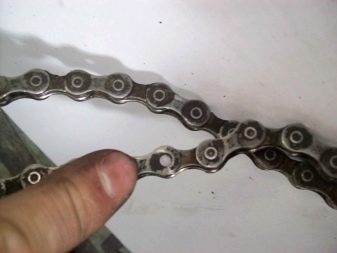
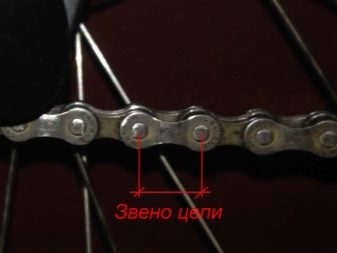
As a result, one pair of links - internal and external (the first goes into the second) - forms a fragment, from which you can make a chain of almost unlimited length. The size of the half link — internal or external — is half an inch. For Half-Link chains, one link enters the other on each pin in the same way. Each link is extended from one end to the other. Here, the links are no longer replaced in pairs, but one by one.

Conventional 108 link chain is used primarily in single speed transmissions where excess chain length is not required... In the assembled and ready-to-use chain drive, the 108-link chain is rigidly attached to the front and rear sprockets and clearly conveys the movement.
Mechanical shifting on most bikes uses a significantly longer chain (110-126 links) - such a margin is necessary so that it covers the largest sprockets in front and behind, and a spring-loaded roller with the same teeth, which is an even smaller sprocket, tightens the chain, eliminating slack and allowing the cyclist to ride at any of the available speeds. On high speed bikes, chain lengths are 114 or more links.



Views
Chains are classified by type for products for single-speed and multi-speed bicycles.
Single speed chains are made from thicker steel. This is primarily due to the absence of neighboring stars on the cassette with the rear sprocket. There is no space limitation that the manufacturer would otherwise save so that the rear of the frame and the bike itself would not "swell" to the right and the bike would not shift the center of gravity off the wheel.
With regular lubrication with at least ordinary engine oil, this chain can travel 10 thousand km or more - it almost does not stretch, and the sprockets with their teeth enter the chain slots along the entire length, effectively distributing the load on the chain and transferring the force from the pedals to the rear wheel. These chains are found on road city bikes and women's cruisers, fixed-gear bicycles, all children's and many teenage models. The design of the chain link is extremely simple: outer and inner plates, pins, rollers ("glasses"). Chain width - 8-11 mm.
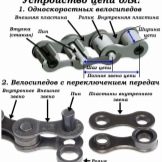
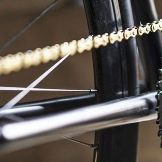
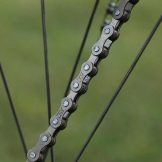
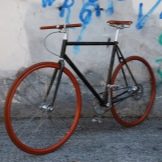
For multi-speed bikes, a narrower chain is used. As an additional part, the pin surrounds the inner glass, and it itself looks thinner. If you put a "single speed" chain on a multi-speed bike, then it will only ride on the largest sprockets. The design will become heavier by an extra kilogram due to the other stars and extra links that have become unnecessary - instead of 108, 126 links are used. Due to the saving of space between the sprockets, when you try to switch to smaller ones in diameter (and go in this gear), the chain will immediately fly off.
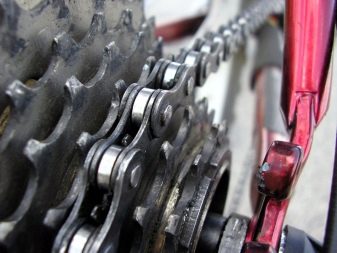
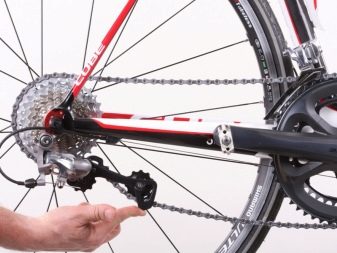
A narrower chain allows technological bending: if a bike with 3 forward and 6 reverse gears is used, then when a combination of 1-3, 2-5 and 3-6 is turned on, the plane in which the chain should be aligned will deviate to the side - which is not observed on single speed bikes. Due to the thinner steel and bending, the wear and elongation of the chain increases by an order of magnitude, and after a run of several hundred or a couple of thousand kilometers, it is changed. Chain width - 6.5-8 mm.
The lightweight bike chain has hollow pins and slotted plates. Reducing the mass of the chain is the lot of racing bicycles, where every gram counts, all the conditions for overtaking rivals on the track are given. But it stretches and breaks more often and faster than a regular multi-speed one.

Half-Link - contains the same repeating link, which is twice as easy to adjust to the overall length required for a particular bike. The plates of each link are curved into sharply defined slopes. It also undergoes destruction faster than a standard two-level chain and cannot be permanently applied for many thousands of kilometers. Such a chain is used on any bicycle, regardless of the number of speeds on it.
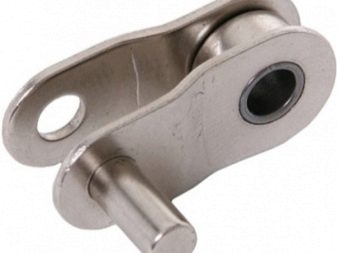

Dimensions and markings
Manufacturer's markings reveal all geometrical parameters of the chain. As an example - ½ "х3 / 16" - 120 links Pinlength 7,3 mm, where:
- ½ – link pitch, or the distance between the pins. It is constant at half an inch (12.7 mm).
- 3/16 Is the distance between the inner link plates. 1/8 "- for single speed bikes and stunt models. 3/16 "- this size is practically out of use, even singlespeeds have bypassed it. 3/32 ”- for bicycles with 6.8-speed cassettes. 11/128 "- for cassettes with 9-11 stars.
- 120 links - the number of links in one chain.
- Pinlength 7.3 mm - the length of the pin, along which a specific chain is selected. Pins that are too short (for, for example, an 8mm chain) will not fit a wider chain (for example, 9mm), it often breaks apart when trying to give a decent amount of force when riding uphill or upwind.
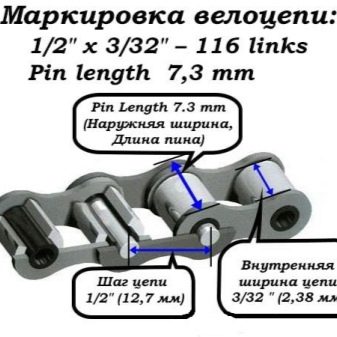
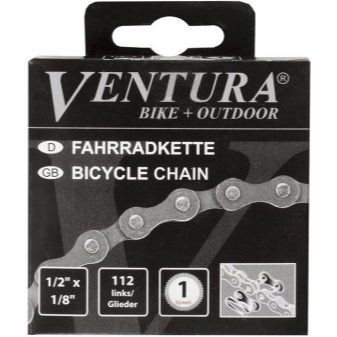
Chains often indicate the ultimate tensile strength. Multi-speed bikes use chains with 500-700 kg of allowable traction. For single-speed ones - 900-1100 kg, in fact, you can lift a small car on it.
An inscription such as 11S indicates 11-speed cassettes.
Materials (edit)
Dark gray hardened bicycle chain. Such steel is used for the manufacture of hardened wire, which is easy to blunt even a bolt cutter, and most tools - for example, screwdrivers and screwdriver bits, where special strength is needed.
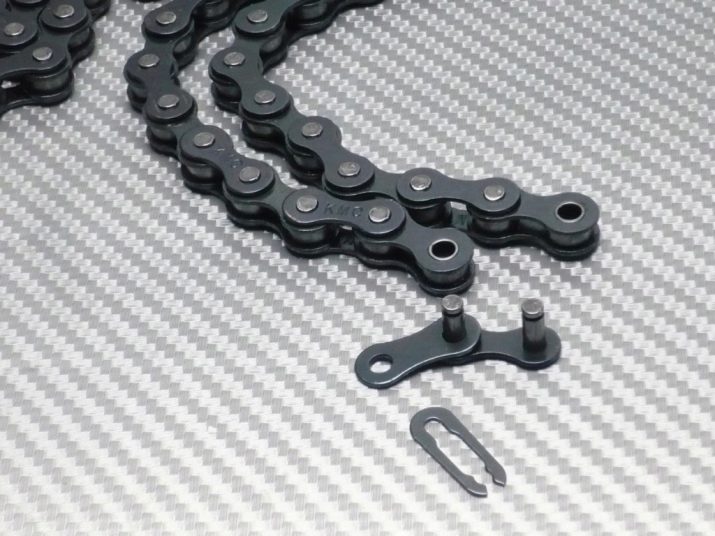
"Gold" color is an indicator of the presence of an anti-corrosion coating. The composition of the bronze-gold coating includes alloying additives of steel, for example, cobalt. This steel is used in the manufacture of multi-stage and conventional drills, has increased hardness and strength.
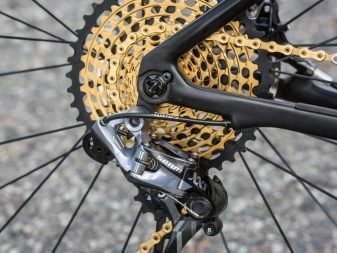
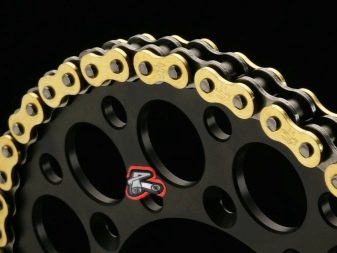
The aluminum chain is nonsense. It would break quickly if the cyclist pushed on the pedals for a quick start. Non-ferrous metal is not used here - it is too soft; any aluminum-based alloys are for frames and forks, not transmission parts. Only steel - and nothing more.
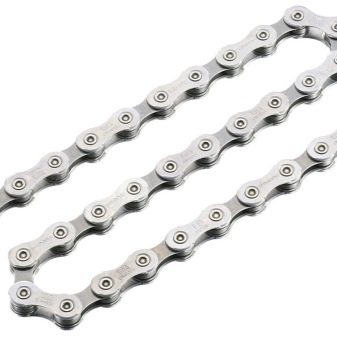
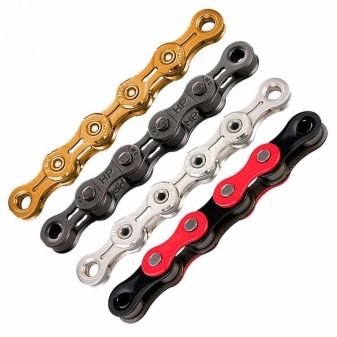
Reinforced chains are mostly single speed. They can be made from both hardened and (partly) stainless steel.
Titanium is very rare. Titanium itself is an expensive material, tens of times more expensive than iron. If, say, a frame for bicycles made of titanium would cost 3000-5000 rubles today, then the bicycle chain would be even more expensive in terms of costs.
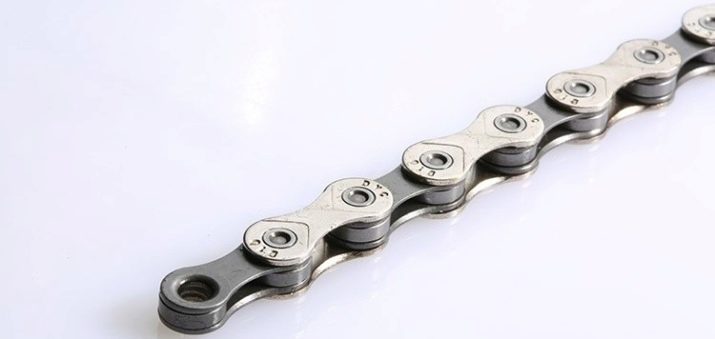
Stainless chain can be made entirely of the same steel, or have a spraying of the same stainless steel. But all types of anti-corrosion coating are erased for several tens or a couple of hundred kilometers, and unprotected steel is exposed.
The best option is to lubricate the chain once a week or 100 km: the oil will protect as well as the metal coating, and will cost much less. It is not for nothing that the manufacturer applies a thin layer of oil to the chain before packing it in an airtight bag.
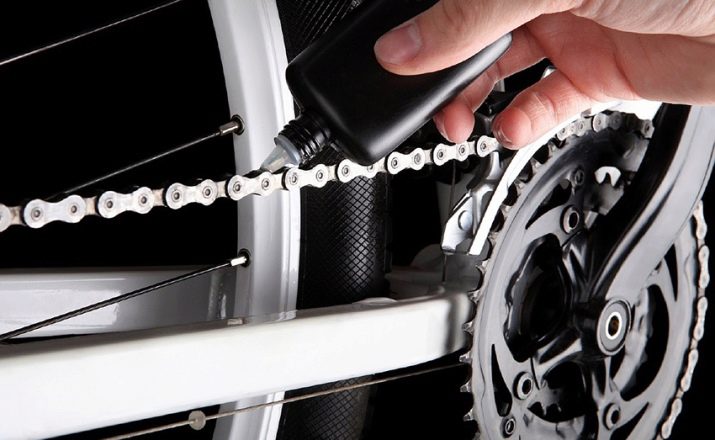
Manufacturers overview
Cycle chains are produced by dozens of companies around the world, but it is possible to find a good chain from the following manufacturers: Japanese Shimano, Italian Campagnolo, American SRAM, Taiwanese KMC (sold in almost any market or bike shop) and German Wipperman. The latter is not inferior in quality, but the overpayment is significant here.
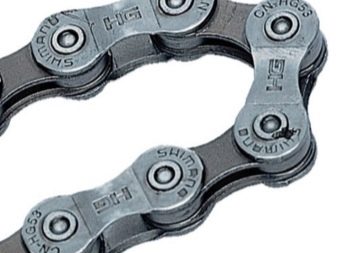

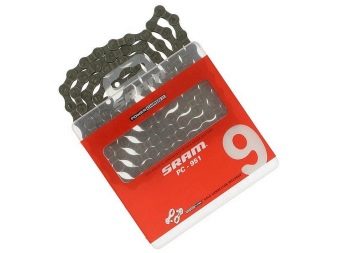

But everyone was outdone by the Soviet-Russian plant "Tyazhmash" - its chains consist of ordinary high-carbon steel, characterized by high wear resistance. This plant produced chains for Soviet road workers. He still specializes in single-speed bicycles, of which there are millions in the country - especially in rural areas and in small towns where a multi-speed bike is not required. Therefore, the production of these chains has not been discontinued. Prices are among the lowest in the country.
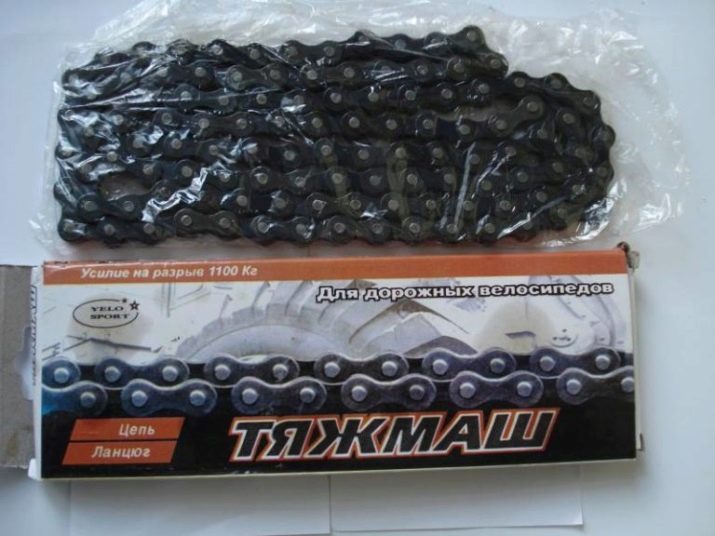
Selection Tips
To select the suitable bike chain, refer to the characteristics indicated in the marking. Correctly selected - specifically for your sprockets - the chain is the key to running more than one thousand kilometers before significant wear of the parts is detected.
For children's bicycles, the length (half) of the link may not be 12.7 mm, but somewhat less - for example, 11.4 mm. From such a chain, you will only take pins and rings as spare parts, but the plates will no longer fit the sprockets of an "adult" bike. The fact is that by putting at least a few "children's" links on the "adult" chain, you will quickly grind the stars. And shortening the chain by at least 3 mm, like lengthening, can kill all parts for some 100-200 km, even when the transmission is cleaned and lubricated weekly.

But the choice of chains with an anti-corrosion coating is not at all necessary. Rather, it’s a desire to impress those who don’t have a bike yet. This coating can be successfully replaced with regular lubrication - even in rainy weather, your chain will not rust. The fact is that machine oil (or its analogue in the form of a semi-liquid lubricant), as well as spraying from another alloy, does not allow water to come to steel. The spraying itself will soon wear off, and you will come to the starting position - the need to regularly lubricate the chain.

Avoid fakes. They are used by Chinese manufacturers and some swindlers who produce chains and bearings from aluminum alloys with a low resource and service life. It happens that they breed steel with cheap additives, turning it into "plasticine" - as in the manufacture of low-quality hex keys, screwdrivers and bits. Violation of the production technology did not lead to any good - numerous breakdowns can no longer be avoided.
And it's good if, when a just broken chain flies off and you are unable to use the foot brake on a single-speed bike, you will not drive into someone else's foreign car parked on the side of the road and crash yourself.
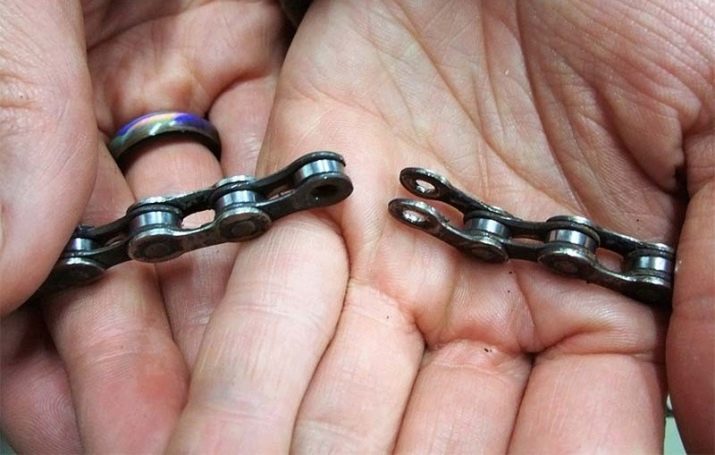
Don't put on an 11-speed bike a wider bike chain designed for, say, 7-speed cassettes. It's all about the number of stars in the cassette: the more there are, the narrower the gap between the planes, in each of which the tops (points) of the same asterisk lie. In contrast, a narrower chain can be fitted to a bike that has fewer speeds.
As an example: the author of these lines used a 6-speed chain on a simple "road" with one speed, where "tyazhmash" products of greater thickness are used. At the same time, the bike was new, he found a bicycle chain with a broken link in the park - and, shortening it by 2 half links, drove 9000 km on it, riding within a radius of up to 25 km from his city on roads of dubious quality, before another link broke. ... The “native” product was taken on every trip as a spare. Do you need such difficulties - it is up to each of you to decide personally.
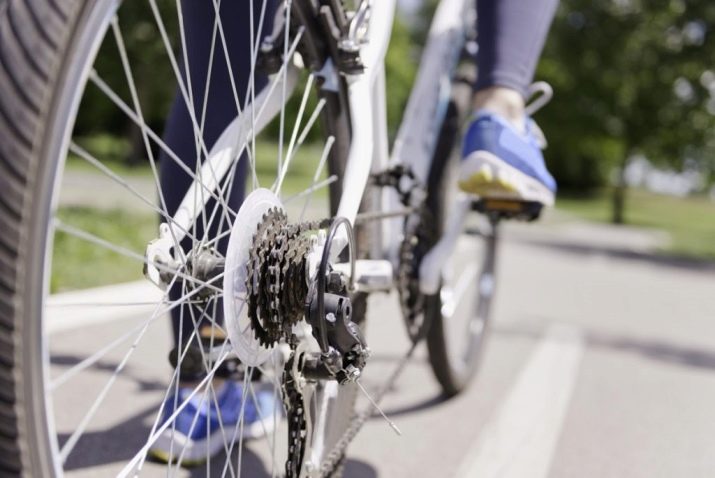
How to install?
To remove and install the bike chain, do the following.
- Turn the bike over with the wheels up. Remove the nuts holding the rear wheel to the frame.
- Remove the bolt holding the bushing “tab” by the special “eyelet” on the frame. This is the third pivot point to prevent the sleeve from turning. Without reliable fixing of the “foot” you will not drive - the bushing mechanism will spin with the sprocket, or it will spin in a few revolutions, and the wheel will generally jam.
- Remove the rear wheel. Together with it, the sleeve with the cassette will come out.
- Remove the bike chain from the cassette. Using a squeeze, open any of the half-links by pushing the pin out of its seat. If there is a lock on the chain, it is not necessary to disassemble the chain in any other place. The chain lock is a special half-link with a detachable outer plate, opened with a screwdriver, a hex key or any other object.
- If one of the (semi) links is broken, and the chain fell off by itself, without removing the rear wheel, open the pins adjacent to the break point and remove the broken link.
- If the old chain is being replaced with a new one, remove the old chain from the chainring. Throw a new one on the same star (in the open state).
- Using a squeeze, replace the broken (half) link with a new one by tightening the pin at the end.
- Slip the bike chain over the rear sprocket, achieve full tension and fix the rear wheel in the same place, tightening all the bolts to the required torque.
- Check if there is any lubricant on the new (or repaired) chain. If it is missing or completely dry, apply a new coat.
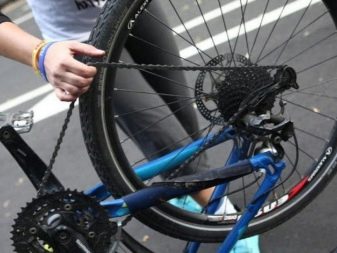
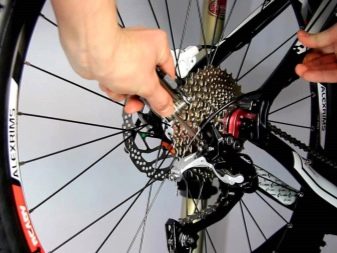
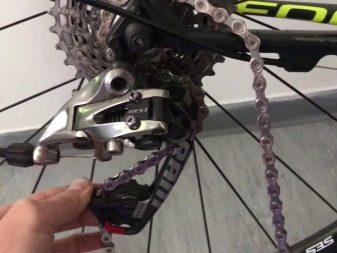

Spin the rear wheel with a pedal, check the acceleration and deceleration of the bike. If everything is done correctly, you can turn the bike over and continue driving.
When should you change?
Change the chain when it has lengthened by at least 2 mm.You can measure the length by opening any pin and spreading the bike chain along the meter ruler. If the standard length has increased by 3 or more millimeters, both parts will need to be replaced.
See the following video for replacing your bike chain.








